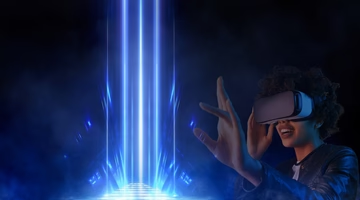
Virtual Reality is a computer-simulated environment that a person can explore and interact with. This environment can be real or imagined. With advancements in technology, Virtual Reality is now increasingly being used as a new medium to tell stories, view movies, train athletes, design architecture and even plan transportation projects.
New technology has often transformed the way people create and consume art by propelling the art creation process in unexpected directions, giving artists more opportunities to interact with their audiences, and enabling them to create in completely new ways. VR is mainly popular in the gaming industry but recently has also started being embraced by museum curators, art galleries like Artizen Art Galleries at Pearey Lal Bhawan, and artists who are exploring its potential, to help them better engage with their audiences.
For the culturally curious, VR is already directly influencing the democratization and experience of art. Tools like Expeditions enable students to take virtual tours of major landmarks and museums using only a smartphone and a VR device. Google’s Arts & Culture app allows people to take virtual tours of museums and explore cultural treasures in extraordinary detail.
VR transforms the creative experience. So for the art world, Virtual Reality or VR has developed a whole new paradigm through which artists can create new styles that are more dynamic and interactive. For instance, Tilt Brush, a VR app by Google that became accessible for free in April 2016, uses a VR headset and motion-tracking controllers as paintbrushes. It enables users to paint life-size three-dimensional brush strokes in a virtual space, or in a way, to create a sculpture by painting.
The tool has also been used as an interactive canvas in museums to create elaborate art installations such as the 2016 Björk Digital exhibition at Somerset House. The Icelandic artist chose VR because of its unique ability to facilitate interactions between different forms of art – in her case music and visual arts.
Several of the characteristics of the virtual art creation process have triggered valid concerns around intellectual property: does the work of art belong to the artist or does it belong to the technology provider who enabled the realisation of the work of art? In the case of Tilt Brush, for example, while artists own their creations, Google retains a worldwide license to use, create or modify them for promotion and improvement of their services.
The technologies behind virtual art will also have an impact on the artists themselves, and the skills needed to build sophisticated installations. Open source movements might allow artists to work together or get involved in the VR space more easily. VR will have an even more radical impact on the creation of new works of art. It will change the way people make art by giving it a new sense of space and dimension and making it more collaborative.
VR will no doubt change the way people produce and create art. However, it won’t destroy traditional visual arts. After all, photography didn’t wipe out painting as an art form. Quite the opposite, it will blur the boundaries between real and virtual and provide new avenues for artistic expression until the next radical art-enabling technologies emerge.




